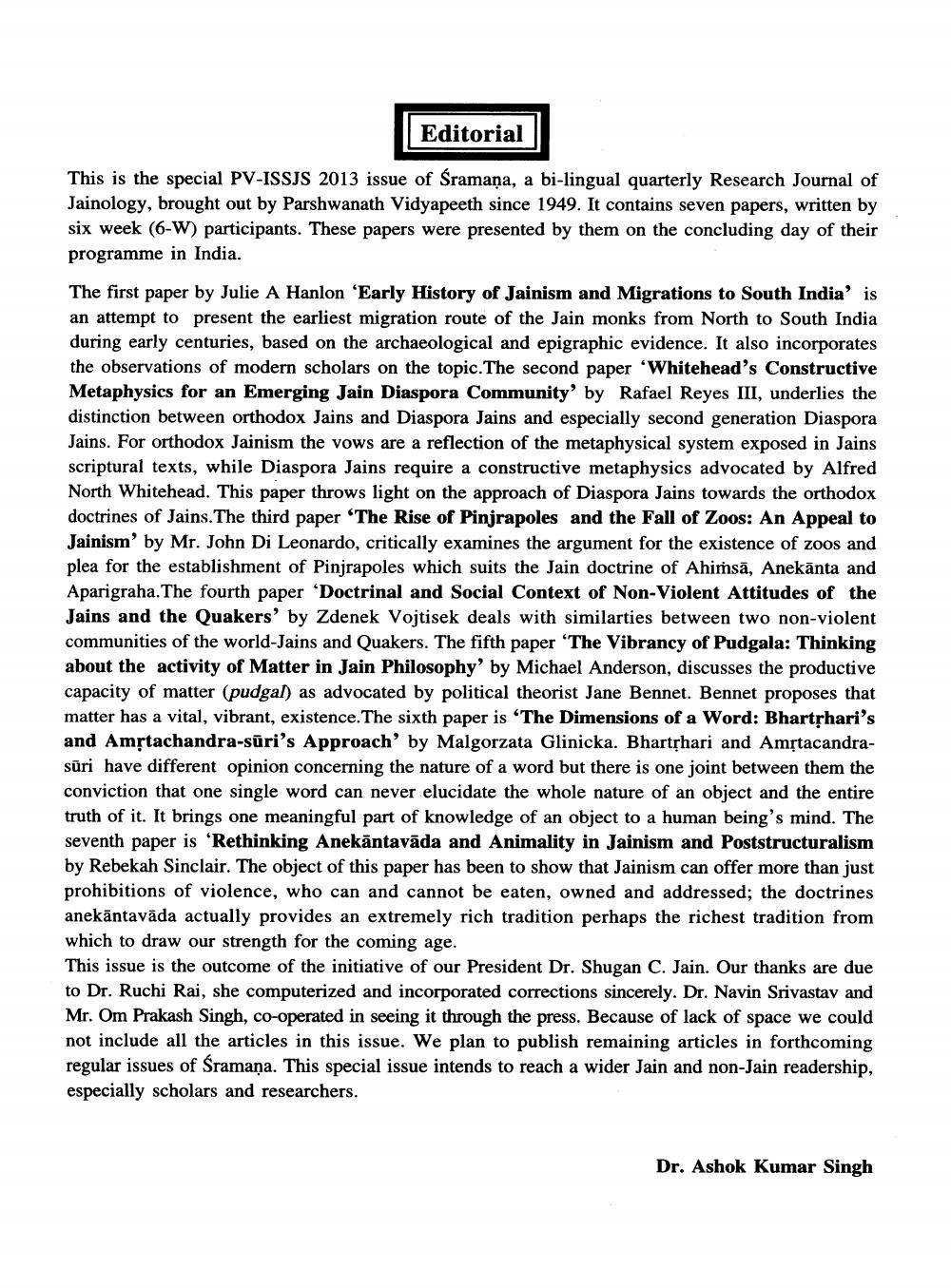________________
Editorial
This is the special PV-ISSJS 2013 issue of Śramaņa, a bi-lingual quarterly Research Journal of Jainology, brought out by Parshwanath Vidyapeeth since 1949. It contains seven papers, written by six week (6-W) participants. These papers were presented by them on the concluding day of their programme in India.
The first paper by Julie A Hanlon 'Early History of Jainism and Migrations to South India' is an attempt to present the earliest migration route of the Jain monks from North to South India during early centuries, based on the archaeological and epigraphic evidence. It also incorporates the observations of modern scholars on the topic. The second paper "Whitehead's Constructive Metaphysics for an Emerging Jain Diaspora Community' by Rafael Reyes III, underlies the distinction between orthodox Jains and Diaspora Jains and especially second generation Diaspora Jains. For orthodox Jainism the vows are a reflection of the metaphysical system exposed in Jains scriptural texts, while Diaspora Jains require a constructive metaphysics advocated by Alfred North Whitehead. This paper throws light on the approach of Diaspora Jains towards the orthodox doctrines of Jains. The third paper "The Rise of Pinjrapoles and the Fall of Zoos: An Appeal to Jainism' by Mr. John Di Leonardo, critically examines the argument for the existence of zoos and plea for the establishment of Pinjrapoles which suits the Jain doctrine of Ahimsā, Anekānta and Aparigraha. The fourth paper 'Doctrinal and Social Context of Non-Violent Attitudes of the Jains and the Quakers' by Zdenek Vojtisek deals with similarties between two non-violent communities of the world-Jains and Quakers. The fifth paper 'The Vibrancy of Pudgala: Thinking about the activity of Matter in Jain Philosophy' by Michael Anderson, discusses the productive capacity of matter (pudgal) as advocated by political theorist Jane Bennet. Bennet proposes that matter has a vital, vibrant, existence.The sixth paper is 'The Dimensions of a Word: Bhartshari's and Amstachandra-sūri's Approach' by Malgorzata Glinicka. Bhartphari and Amrtacandrasūri have different opinion concerning the nature of a word but there is one joint between them the conviction that one single word can never elucidate the whole nature of an object and the entire truth of it. It brings one meaningful part of knowledge of an object to a human being's mind. The seventh paper is 'Rethinking Anekāntavāda and Animality in Jainism and Poststructuralism by Rebekah Sinclair. The object of this paper has been to show that Jainism can offer more than just prohibitions of violence, who can and cannot be eaten, owned and addressed; the doctrines anekāntavāda actually provides an extremely rich tradition perhaps the richest tradition from which to draw our strength for the coming age. This issue is the outcome of the initiative of our President Dr. Shugan C. Jain. Our thanks are due to Dr. Ruchi Rai, she computerized and incorporated corrections sincerely. Dr. Navin Srivastav and Mr. Om Prakash Singh, co-operated in seeing it through the press. Because of lack of space we could not include all the articles in this issue. We plan to publish remaining articles in forthcoming regular issues of Śramaņa. This special issue intends to reach a wider Jain and non-Jain readership, especially scholars and researchers.
Dr. Ashok Kumar Singh




